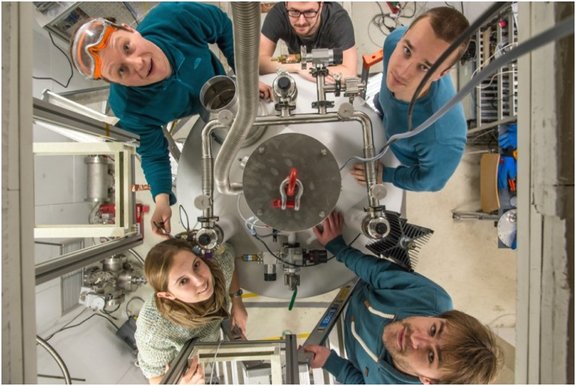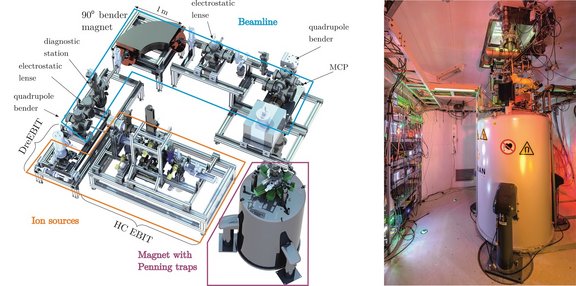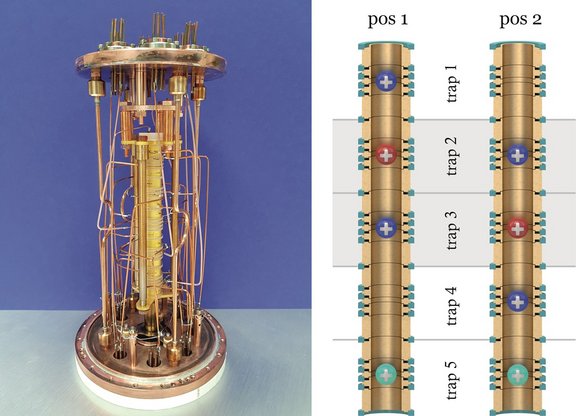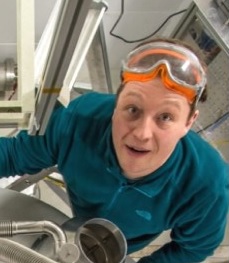PENTATRAP
The PENTATRAP experiment
The Penning-trap mass spectrometer PENTATRAP performs mass-ratio measurements on long-lived, highly charged, heavy ions with a precision on the order of δm/m <= 10-11 or better. Unique for PENTATRAP are the synchronously operated five traps [1,2], a self-build ultrastable voltage source [3] and access to external ion sources [4,5].
The complete experiment extends over two floors. The ion sources and the beamline are located on the ground floor of the experimental hall at the MPIK. For stable experimental conditions the magnet is housed one floor below in a temperature and pressure stabilized lab.
References
| [1] | PENTATRAP: a novel cryogenic multi-Penning-trap experiment for high-precision mass measurements on highly charged ions, J. Repp et al., Appl. Phys. B 107, 983-996 (2012) |
| [2] | The trap design of PENTATRAP, C. Roux et al., Appl. Phys. B 107, 997-1005 (2012) |
| [3] | An ultra-stable voltage source for precision Penning-trap experiments, Ch. Böhm et al., Nucl. Instrum. Methods A 828, 125-131 (2016) |
| [4] | DREEBIT GmbH, Dresden. Instruction manual - Dresden EBIT with Wien Filter 2010 |
| [5] | The Heidelberg compact electron beam ion traps, P. Micke et al., Rev. Sci. Instrum. 89, 063109 (2018) |
EMMI
The research within the framework of the PENTATRAP project has close affiliation with the goals of the Extreme Matter Institute (EMMI) at GSI/Darmstadt. The institute was created by the Helmholtz Alliance "Extremes of Density and Temperature: Cosmic Matter in the Laboratory". This Alliance connects GSI with 7 national partners (among them the Max Planck Institute for Nuclear Physics at Heidelberg) as well as 4 international partners. With EMMI Europe will get a unique infrastructure for interdisciplinary investigations of matter under extreme conditions.
ERC Advanced Grant
This project receives funding from the European Research Council (ERC) under the European Union's Horizon 2020 research and innovation programme under grant agreement No 832848 - FunI.
Highly charged ions are produced in one of two electron beam ion trap (EBIT) attached to the PENTATRAP beamline. The material of interest is hereby subsequently ionised by electron impact ionisation. The ions are ejected from the EBITs with an energy of several keV per charge state. The ions of interest are selected and slowed down in the beamline.
PENTATRAP has access two to EBITs, a commercial DreEBIT [4] and a Heidelberg compact EBIT [5]. In order to also produce ions from samples with small quantities (e.g. on the order of 10ng), a laser ablation setup was included in the latter [6].
References
| [4] | DREEBIT GmbH, Dresden. Instruction manual - Dresden EBIT with Wien Filter 2010 |
| [5] | The Heidelberg compact electron beam ion traps, P. Micke et al., Rev. Sci. Instrum. 89, 063109 (2018) |
| [6] | Production of highly charged ions of rare species by laser-induced desorption inside an electron beam ion trap, Ch. Schweiger et al., Rev. Sci. Instrum. 90, 123201 (2019) |
The Penning trap stack consists of five Penning traps. Currently, four of them (trap 1 to 4) are used for measurements, while in the future trap 5 will be used as a monitor trap for voltage or magnetic field fluctuations.
The currently used measurement scheme, shown above, allows a cancellation of possible magnetic field drifts during the measurements in trap 2 and 3. The frequency ratio (of ions with the same charge state) at position 1 of the ions in trap 2 and 3 is:

Combining both measurements yields a final ratio independent of the magnetic field of the traps, provided the magnetic field ratio is constant over time:

At PENTATRAP, the ions frequencies are determined with the image current detection technique. The axial eigenfrequency is directly measured as the dip in the noise spectrum of the resonator. The magnetron and modified cyclotron frequency are measured by coupling them to the axial motion and using the double dip (magnetron) or PnP (mod. cyclotron) technique.
E=mc2: A test of Einstein’s special relativity is possible by investigating the neutron capture process in 35Cl. The energy released during this process is measured the ILL in Grenoble and compared to the mass difference of 35Cl and 36Cl:
A previous test hast already lead to an agreement of E=mc2 to a level of 1−Δmc2/E = (−1.4±4.4)·10−7 [7].
Dark matter: For measurements of linearity in King plots the mass is an important ingredient in the dark matter search. PENTATRAP will provide masses of isotope strings of Ca and Yb.
Neutrino physics: Since the discovery of neutrino oscillations, it is known that the neutrino has a mass. The ECHo (Electron capture in 163Ho experiment) collaboration [8] is investigating the released energy spectrum of 163Dy following a capture of an inner shell electron into the nucleus in 163Ho:
As an independent cross check, the QEC value of the transition can be determined as the mass difference of Ho and Dy with PENTATRAP.
Binding energy: By determining the mass difference of ions in different charge states, the binding energy of the extra electron can be measured and compared to quantum electrodynamics [9]. For example in Xe:
Metastable states: The mass of an ion with one electron in an excited, long-lived electronic state can be measured as the mass difference to the ion in the ground state. Such direct measurement of excitation energies in highly harged ions can be used as input data to further improve theoretical models. These can then predict possible clock transitions in highly charged ions for a new generation of clocks [10].
References
| [7] | A direct test of E=mc2, S. Rainville, J. K. Thompson, E. G. Myers, et al., Nature 438, 1096–1097 (2005) |
| [8] | The electron capture in 163Ho experiment – ECHo, L. Gastaldo et al., Eur. Phys. J. Spec. Top. 226, 1623–1694 (2017) |
| [9] | Mass-Difference Measurements on Heavy Nuclides with an eV/c2 Accuracy in the PENTATRAP Spectrometer, A. Rischka et al., Phys. Rev. Lett. 124, 113001 (2020) |
| [10] | Detection of metastable electronic states by Penning-trap mass spectrometry, R. X. Schüssler et al., Nature 581, 42–46 (2020) |
PENTATRAP members

Current members (Links to theses performed at PENTATRAP):
- Menno Door (Bachelor thesis , Master thesis)
- Dr. Sergey Eliseev (PI, Habilitation treatise )
- Dr. Pavel Filianin (PhD thesis )
- Dr. Wenjia Huang
- Kathrin Kromer (Master thesis )
- Daniel Lange (Bachelor thesis )
- Christoph Schweiger (Master thesis )
Guests:
- Yuri Novikov
- Olesia Bezrodnova
Former members:
Dr. Rima Schüssler (Master thesis , PhD thesis ), Jost Herkenhoff (Bachelor thesis ), Charlotte König (Master thesis ), Dr. Alexander Rischka (Bachelor thesis , Master thesis , PhD thesis ), Marius Müller (Bachelor thesis ), Janina Engelhardt, Dr. Andreas Dörr (PhD thesis ), Dr. Christine Böhm (PhD thesis ), Dr. Mikhail Goncharov (PhD thesis ), Dr. Julia Repp (PhD thesis ), Dr. Christian Roux (PhD thesis ), Dr. Sebastion George (PhD thesis )
17 Penning-trap measurement of the Q value of electron capture in 163Ho for the determination of the electron neutrino mass
C. Schweiger, M. Braß, V. Debierre, M. Door, H. Dorrer, C. E. Düllmann, C. Enss, P. Filianin, L. Gastaldo, Z. Harman, M. W. Haverkort, J. Herkenhoff, P. Indelicato, C. H. Keitel, K. Kromer, D. Lange, Y. N. Novikov, D. Renisch, A. Rischka, R. X. Schüssler, S. Eliseev, and K. Blaum
Nature Physics (2024)
16 Atomic mass determination of uranium-238
K. Kromer, C. Lyu, J. Bieron, M. Door, L. Enzmann, P. Filianin, G. Gaigalas, Z. Harman, J. Herkenhoff, W. Huang, C. H. Keitel, S. Eliseev, and K. Blaum
Physical Review C 109, L021301 (2024)
15 High-Precision Determination of g Factors and Masses of 20Ne9+ and 22Ne9+
F. Heiße, M. Door, T. Sailer, P. Filianin, J. Herkenhoff, C. M. König., K. Kromer, D. Lange, J. Morgner, A. Rischka, C.. Schweiger, B. Tu, Y. N. Novikov, S. Eliseev, S. Sturm, and K. Blaum
Physical Review Letters 131, 253002 (2023)
14 Observation of a Low-Lying Metastable Electronic State in Highly Charged Lead by Penning-Trap Mass Spectrometry
K. Kromer, C. Lyu, M. Door, P. Filianin, Z. Harman, J. Herkenhoff, P. Indelicato, C. H. Keitel, D. Lange, Y. N. Novikov, C. Schweiger, S. Eliseev, and K. Blaum
Physical Review Letters 131, 223002 (2023)
13 High-precision Penning-trap mass spectrometry for neutrino physics
S. Eliseev and Y. Novikov
European Physical Journal A 59, 34 (2023)
12 High-precision mass measurement of doubly magic 208Pb
K. Kromer, C. Lyu, M. Door, P. Filianin, Z. Harman, J. Herkenhoff, W. Huang, C. H. Keitel, D. Lange, Y. N. Novikov, C. Schweiger, S. Eliseev, and K. Blaum
The European Physical Journal A: Hadrons and Nuclei 58, 202 (2022)
Erratum
11 Fast silicon carbide MOSFET based high-voltage push–pull switch for charge state separation of highly charged ions with a Bradbury–Nielsen gate
C. Schweiger, M. Door, P. Filianin, J. Herkenhoff, K. Kromer, D. Lange, D. Marschall, A. Rischka, T. Wagner, S. Eliseev, and K. Blaum
Review of Scientific Instruments 93, 094702 (2022)
10 A digital feedback system for advanced ion manipulation techniques in Penning traps
J. Herkenhoff, M. Door, P. Filianin, W. Huang, K. Kromer, D. Lange, R. X. Schüssler, C. Schweiger, S. Eliseev, and K. Blaum
Review of Scientific Instruments 92, 103201 (2021)
9 Direct Q-Value Determination of the β− Decay of 187Re
P. E. Filianin, C. Lyu, M. Door, K. Blaum, W. J. Huang, M. Haverkort, P. Indelicato, C. H. Keitel, K. Kromer, D. Lange, Y. N. Novikov, A. Rischka, R. X. Schüssler, C. Schweiger, S. Sturm, S. Ulmer, Z. Harman, and S. Eliseev
Physical Review Letters 127, 072502 (2021)
MPIK press release: Important measuring method of neutrino physics on the test bench
MPIK-Pressemitteilung: Wichtige Messmethode der Neutrinophysik auf dem Prüfstand
idw press release: Important measuring method of neutrino physics on the test bench
8 Perspectives on testing fundamental physics with highly charged ions in Penning traps
K. Blaum, S. Eliseev, and S. Sturm
Quantum Science and Technology 6, 014002 (2020)
7 Detection of metastable electronic states by Penning trap mass spectrometry
R. X. Schüssler, H. Bekker, M. Braß, H. Cakir, J. R. Crespo López Urrutia, M. Door, P. E. Filianin, Z. Harman, M. W. Haverkort, W. J. Huang, P. Indelicato, C. H. Keitel, C. M. König., K. Kromer, M. Müller, Y. N. Novikov, A. Rischka, C. Schweiger, S. Sturm, S. Ulmer, S. Eliseev, and K. Blaum
Nature 581, 42-46 (2020)
Nature News & Views: Mass spectrometry for future atomic clocks
MPIK press release: Quantum jump tipping the balance
MPIK-Pressemitteilung: Quantensprung auf der Waage
MPG press release: Quantum jump tipping the balance
MPG-Pressemitteilung: Quantensprung auf der Waage
idw press release: Quantum jump tipping the balance
phys.org: Successfully measuring infinitesimal change in mass of individual atoms for the first time
Focus Online: Quantensprung auf der Waage
wissenschaft.de: Quantensprung auf der Waage
Physik in unserer Zeit: Quantensprung auf der Waage
Frankfurter Allgemeine Zeitung: Wie viel wiegt ein Quantensprung?
6 Mass-Difference Measurements on Heavy Nuclides with an eV/c2 Accuracy in the PENTATRAP Spectrometer
A. Rischka, H. Cakir, M. Door, P. Filianin, Z. Harman, W. J. Huang, P. Indelicato, C. H. Keitel, C. M. König, K. Kromer, M. Müller, Y. N. Novikov, R. X. Schüssler, C. Schweiger, S. Eliseev, and K. Blaum
Physical Review Letters 124, 113001 (2020)
5 High-resolution and low-background 163Ho spectrum: interpretation of the resonance tails
C. Velte, F. Ahrens, A. Barth, K. Blaum, M. Braß, M. Door, H. Dorrer, C.. E. Düllmann, S. Eliseev, C. Enss, P. E. Filianin, A. Fleischmann, L. Gastaldo, A. Goeggelmann, T. D. Goodacre, M. W. Haverkort, D. Hengstler, J. Jochum, K. Johnston, M. Keller, S. Kempf, T. Kieck, C. König, U. Köster, K. Kromer, F. Mantegazzini, B. Marsh, Y.. N. Novikov, F. Piquemal, C. Riccio, D. Richter, A. Rischka, S. Rothe, R. X. Schüssler, C. Schweiger, T. Stora, M. Wegner, K. Wendt, M. Zampaolo, and K. Zuber
European Physical Journal C 79, 1026 (2019)
4 Production of highly charged ions of rare species by laser-induced desorption inside an electron beam ion trap
C. Schweiger, C. König, J. R. Crespo López-Urrutia, M. Door, H. Dorrer, C. E. Düllmann, S. Eliseev, P. Filianin, W. Huang, K. Kromer, P. Micke, M. Müller, D. Renisch, A. Rischka, R. Schüssler, and K. Blaum
Review of Scientific Instruments 90, 123201 (2019)
3 An ultra-stable voltage source for precision Penning-trap experiments
C. Böhm, S. Sturm, A. Rischka, A. Dörr, S. Eliseev, M. Goncharov, M. Höcker, J. Ketter, F. Köhler, J. Repp, C. Roux, R. Schüssler, S. Streubel, R. Zirpel, J. Melcher, and K. Blaum
Nuclear Instruments and Methods in Physics Research Section A: Accelerators, Spectrometers, Detectors and Associated Equipment 828, 125-131 (2016)
2 The trap design of PENTATRAP
C. Roux, C. Böhm, A. Dörr, S. Eliseev, S. George, M. Goncharov, Y. N. Novikov, J. Repp, S. Sturm, S. Ulmer, and K. Blaum
Applied Physics B: Lasers and Optics 107, 997-1005 (2012)
1 PENTATRAP: a novel cryogenic multi-Penning-trap experiment for high-precision mass measurements on highly charged ions
J. Repp, C. Böhm, J. Crespo López-Urrutia, A. Dörr, S. Eliseev, S. George, M. Goncharov, Y. N. Novikov, C. Roux, S. Sturm, S. Ulmer, and K. Blaum
Applied Physics B: Lasers and Optics 107, 983-996 (2012)






